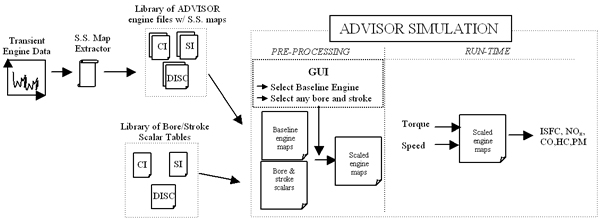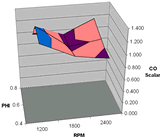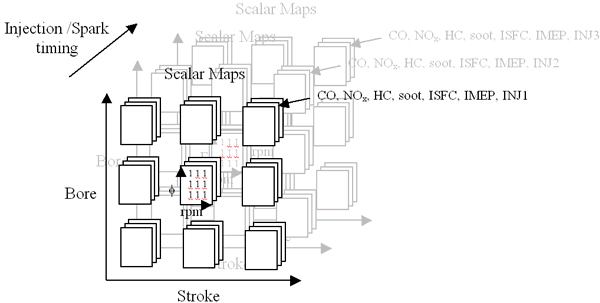|
|
|
| |
|
|
|
| Engine
Simulations
Hybrid Electric
Vehicle Engines
TECAT Engineering has
developed an algorithm to predict the performance and emissions for families
of engines used within a hybrid electric vehicle simulator. This algorithm
has been incorporated into the ADVISOR and PSAT Hybrid Electric Vehicle
models. ADVISOR is the ADvanced VehIcle SimulatOR developed at the National
Renewable Energy Laboratory. PSAT, the Powertrain System Analysis
Toolkit, was developed by Argonne
National Laboratory and is sponsored by the US Department of Energy.
Both tools have been developed to assist the automotive engineering community
to quickly simulate the performance of a large number of vehicle design
options. |
|
 |
|
This
TECAT Engineering algorithm is based on a scalar model of existing engines. Taking user
defined bore and stroke, the algorithm predicts the brake specific quantities
of NOx, CO and fuel consumption. An oil film adsorption/desorption model
and a crevice flow model have been added to the algorithm to predict exhaust
hydrocarbons as well. The resulting emissions and performance maps at various
engine displacements are then used within one of the HEV simulators mentioned
above, to determine optimal sizing between the internal combustion engine
and the electric drive system, subject to known driving schedules and charging
strategies.
|
|
|
| The
scaling algorithm uses steady state data engine data and scaling factors
generated from simulated WinKiva results for various combustion chamber
shapes. The engine data and scaling factors are then combined to predict
performance and emissions data for any engine size. When steady state engine
data is not available, the algorithm can extract the data from transient
engine schedules. This technique has been numerically validated by comparing
actual steady state simulated maps with steady state maps created from transient
schedule simulations. At each bore and stroke, a torque vs. speed sweep
is performed to evaluate performance and emissions over the entire engine
map. The scaling algorithm can then interpolate within the resulting data
for any bore, stroke, torque and speed input. The algorithm may easily be
expanded to include the effects of operating conditions such as the injection/spark
timing. |
|
|
|
| |
|
Copyright
© 2008 TECAT Engineering, Incorporated. All Rights Reserved.
|
|
|
|
|
|
|




